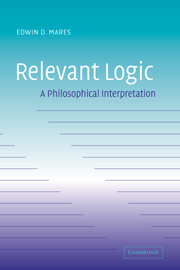Book contents
- Frontmatter
- Contents
- Preface
- Acknowledgements
- I Relevant logic and its semantics
- 1 What is relevant logic and why do we need it?
- 2 Possible worlds and beyond
- 3 Situating implication
- 4 Ontological interlude
- 5 Negation
- 6 Modality, entailment and quantification
- II Conditionals
- III Inference and its applications
- Appendix A The logic R
- Appendix B Routley–Meyer semantics for R
- Glossary
- References
- Index
2 - Possible worlds and beyond
Published online by Cambridge University Press: 03 September 2009
- Frontmatter
- Contents
- Preface
- Acknowledgements
- I Relevant logic and its semantics
- 1 What is relevant logic and why do we need it?
- 2 Possible worlds and beyond
- 3 Situating implication
- 4 Ontological interlude
- 5 Negation
- 6 Modality, entailment and quantification
- II Conditionals
- III Inference and its applications
- Appendix A The logic R
- Appendix B Routley–Meyer semantics for R
- Glossary
- References
- Index
Summary
Introduction
In this chapter we present the ‘relational’ semantics for relevant logic. We begin by introducing the motivations for truth-theoretic semantics. We also look at the possible world semantics for modal logics. The semantics for relevant logic is a modification of the semantics for modal logics. Looking at the semantics for modal logics will allow us to introduce in an easier form certain ideas that are repeated in the relevant semantics. In addition, as we shall see, the modal semantics has certain important virtues. We shall show, in this and the next chapter, that the relevant semantics has these virtues as well.
Why truth-theoretic semantics?
In the last chapter we looked at a fragment of the natural deduction system for a relevant logic. We saw that it uses similar rules to those of the natural deduction system for classical logic, but restricts them by forcing the premises of an argument really to be used in that argument. Why not stop there and say that this is all there is to relevant logic? There is something still missing. First, we need to understand the rest of the logic – its treatment of conjunction, disjunction and negation. As we shall see, it is difficult to interpret them entirely in terms of the natural deduction system. Second, what we have said so far is inadequate as an interpretation of implication. We also need some way of understanding, not only how to prove that an implication is true, but what it means for an implication to be true.
- Type
- Chapter
- Information
- Relevant LogicA Philosophical Interpretation, pp. 19 - 38Publisher: Cambridge University PressPrint publication year: 2004



